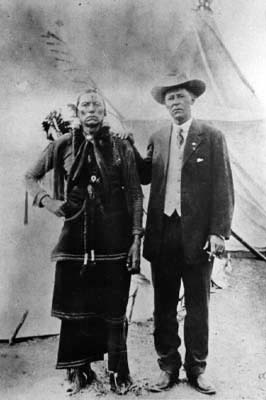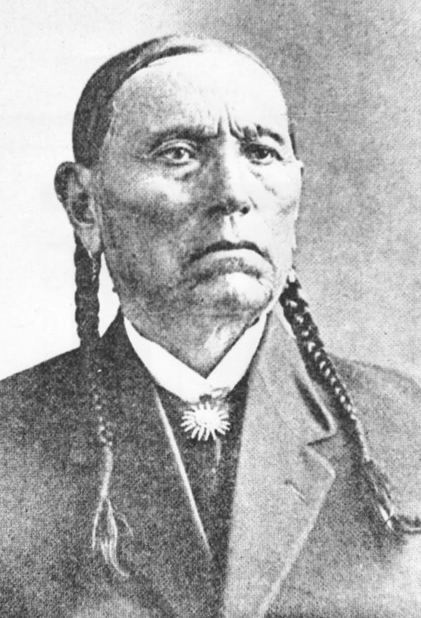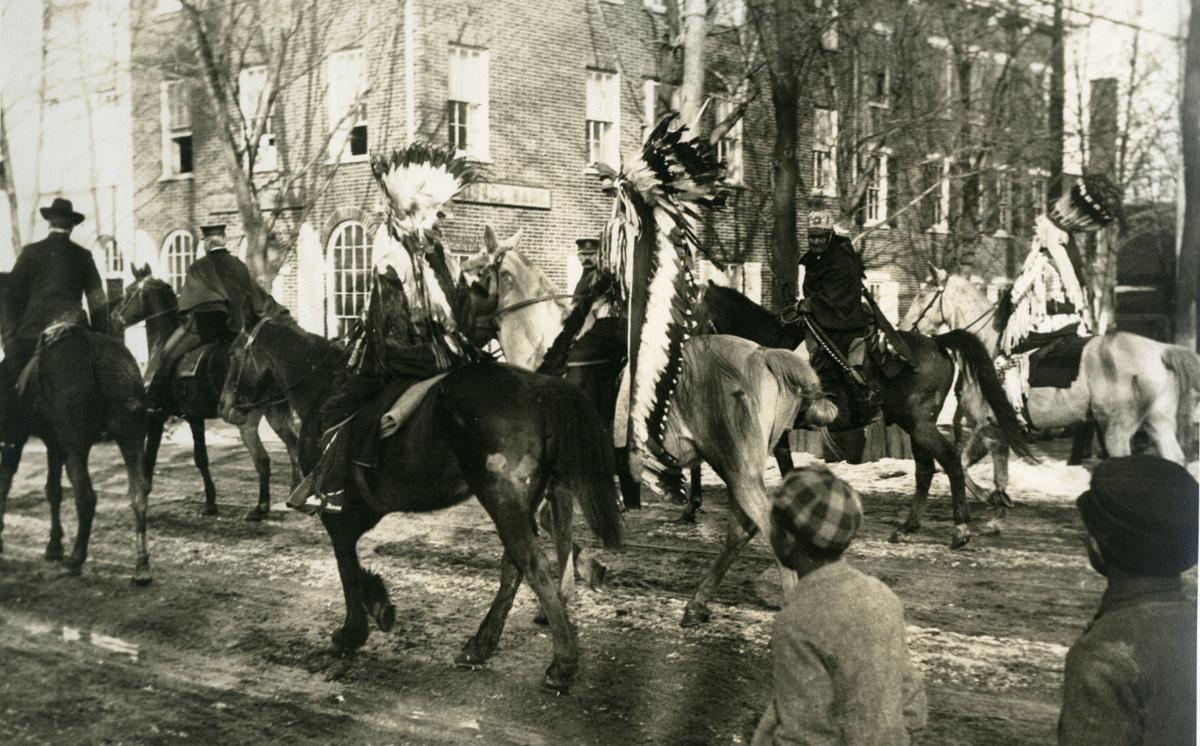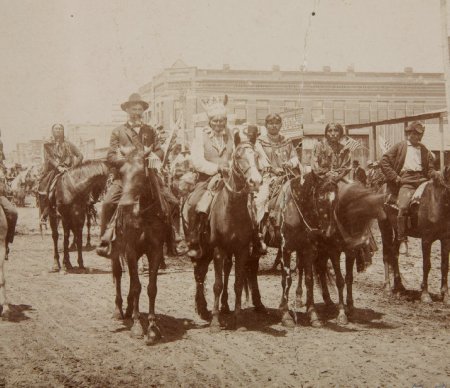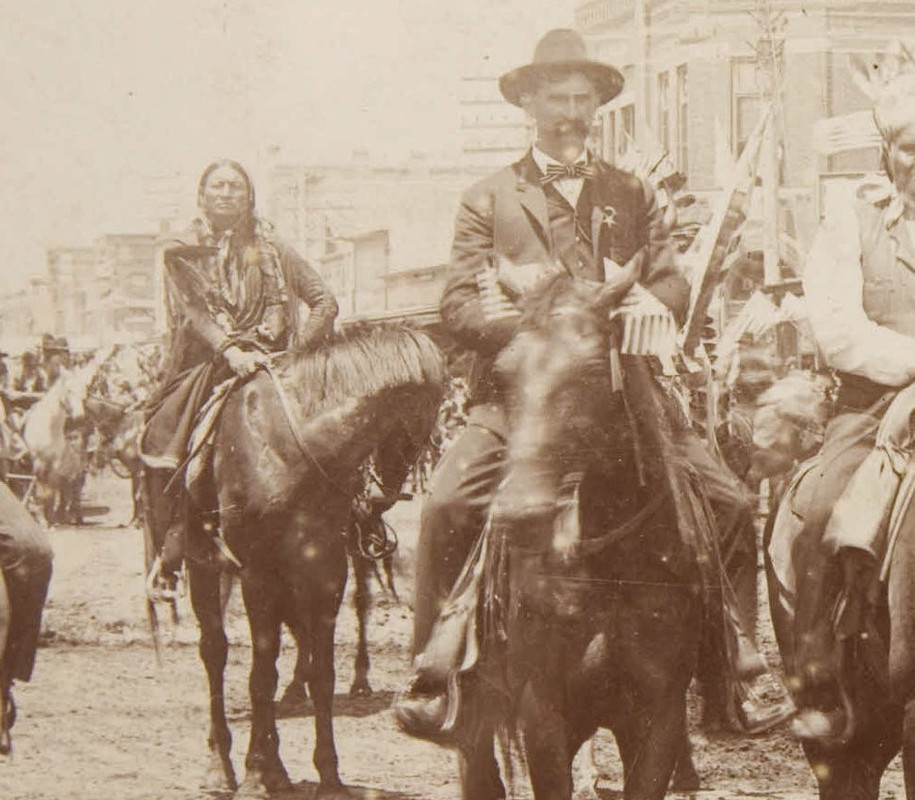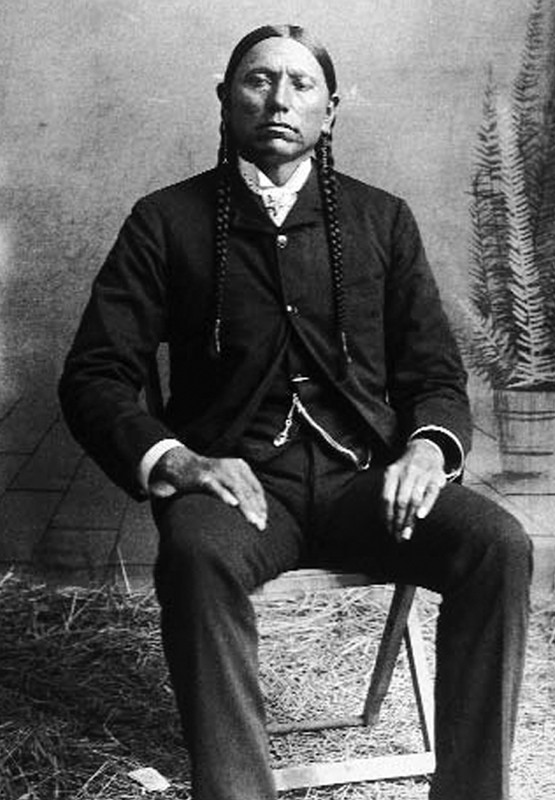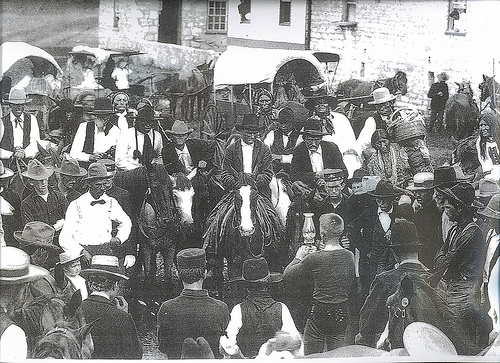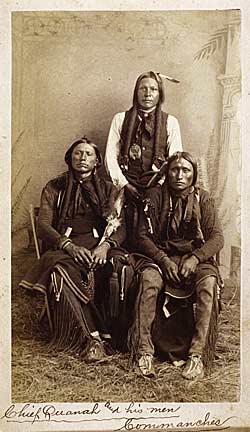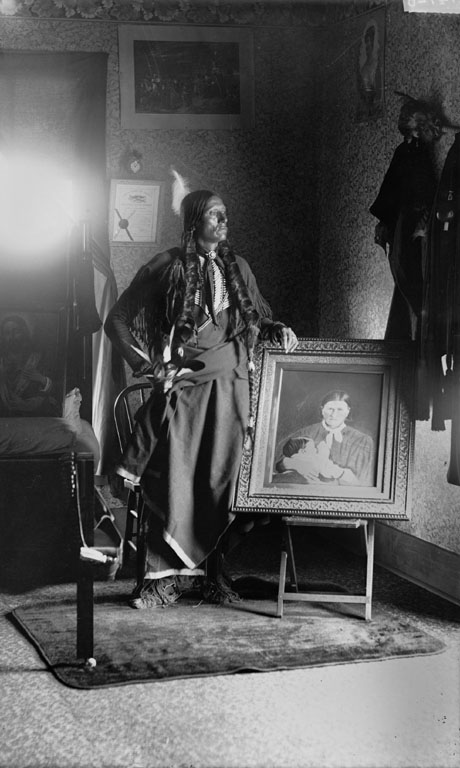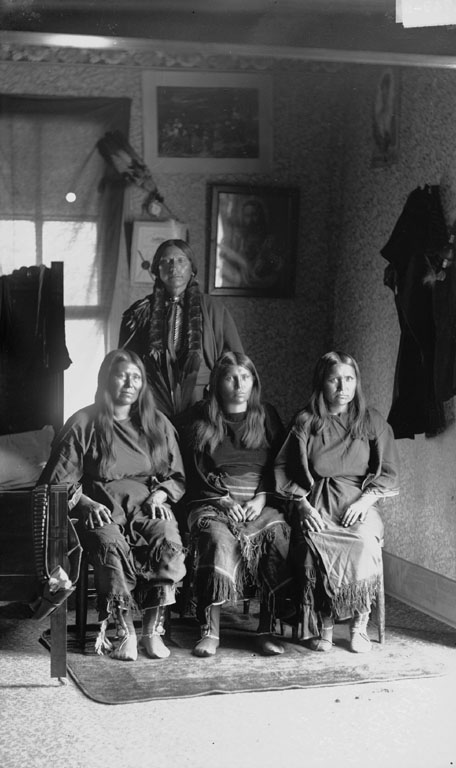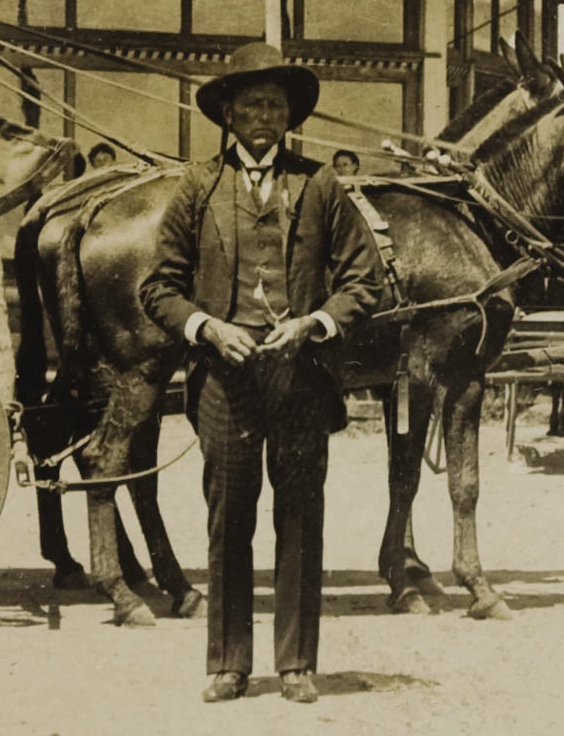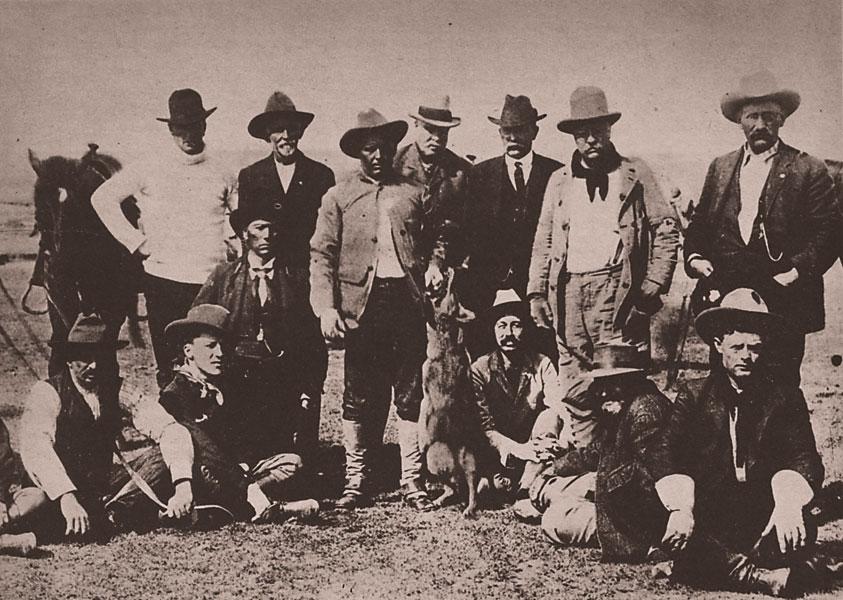Post by Historian on May 24, 2009 20:00:26 GMT -5
Quanah Parker was the last Chief of the Commanches and never lost a battle to the white man. His tribe roamed over the area where Pampas stands. He was never captured by the Army, but decided to surrender and lead his tribe into the white man's culture, only when he saw that there was no alternative.
His was the last tribe in the Staked Plains to come into the reservation system.
Quanah, meaning "fragrant," was born about 1850, son of Comanche Chief Peta Nocona and Cynthia Ann Parker, a white girl taken captive during the 1836 raid on Parker's Fort, Texas. Cynthia Ann Parker was recaptured, along with her daughter, during an 1860 raid on the Pease River in northwest Texas. She had spent 24 years among the Comanche, however, and thus never readjusted to living with the whites again.
She died in Anderson County, Texas, in 1864 shortly after the death of her daughter, Prairie Flower. Ironically, Cynthia Ann's son would adjust remarkably well to living among the white men. But first he would lead a bloody war against them.
Quanah and the Quahada Comanche, of whom his father, Peta Nocona had been chief, refused to accept the provisions of the 1867 Treaty of Medicine Lodge, which confined the southern Plains Indians to a reservation, promising to clothe the Indians and turn them into farmers in imitation of the white settlers.
Knowing of past lies and deceptive treaties of the "White man", Quanah decided to remain on the warpath, raiding in Texas and Mexico and out maneuvering Army Colonel Ronald S. Mackenzie and others. He was almost killed during the attack on buffalo hunters at Adobe Walls in the Texas Panhandle in 1874. The U.S. Army was relentless in its Red River campaign of 1874-75. Quanah's allies, the Quahada were weary and starving.
Mackenzie sent Jacob J. Sturm, a physician and post interpreter, to solicit the Quahada's surrender. Sturm found Quanah, whom he called "a young man of much influence with his people," and pleaded his case. Quanah rode to a mesa, where he saw a wolf come toward him, howl and trot away to the northeast. Overhead, an eagle "glided lazily and then whipped his wings in the direction of Fort Sill," in the words of Jacob Sturm. This was a sign, Quanah thought, and on June 2, 1875, he and his band surrendered at Fort Sill in present-day Oklahoma.
Biographer Bill Neeley writes:
"Not only did Quanah pass within the span of a single lifetime from a Stone Age warrior to a statesman in the age of the Industrial Revolution, but he accepted the challenge and responsibility of leading the whole Comanche tribe on the difficult road toward their new existence."
Quanah was traveling the "white man's road," but he did it his way. He refused to give up polygamy, much to the reservation agents' chagrin. Reservation agents being political appointees of the Federal Government, their main concern was to destroy all vestiges of Native American life and replace their culture with that of theirs. Quanah Parker also used peyote, negotiated grazing rights with Texas cattlemen, and invested in a railroad. He learned English, became a reservation judge, lobbied Congress and pleaded the cause of the Comanche Nation. Among his friends were cattleman Charles Goodnight and President Theodore Roosevelt. He considered himself a man who tried to do right both to the people of his tribe and to his "pale-faced friends".
It wasn't easy. Mackenzie appointed Quanah Parker as the chief of the Comanche shortly after his surrender, but the older chiefs resented Parker’s youth, and his white blood in particular." And in 1892, when Quanah Parker signed the Jerome Agreement that broke up the reservation, the Comanche were split into two factions: (1). those who realized that all that could be done had been one for their nation; and (2). those who blamed Chief Parker for selling their country."
Quanah Parker died on February 23, 1911, and was buried next to his mother, whose body he had reinterred at Ft. Sill Military cemetery on Chiefs Knoll in Oklahoma only three months earlier. For his courage, integrity and tremendous insight, Quanah Parker’s life tells the story of one of America's greatest leaders and a true Texas Hero.
Taken from:
www.lone-star.net/mall/texasinfo/quanah.htm
*******
Quanah Parker (c. late 1840s - February 23, 1911) was a Native American Indian leader, the son of Comanche chief Peta Nocona and European American woman Cynthia Ann Parker, and the last chief of the Quahadi Comanche Indians.
Quanah Parker's mother, Cynthia Ann Parker {b.ca 1827}, was a member of the large Parker frontier family that settled in east Texas in the 1830s. She was captured in 1836 by Comanches during the raid of Fort Parker near present-day Groesbeck, Texas. She was given the Indian name Nadua ("Someone Found"), and adopted into the Nocona band of Comanches. Cynthia Ann eventually married the Comanche warrior Noconie, (aka Tah-con-ne-ah-pe-ah) (called Peta Nocona by the whites), who was a Mexican captive. Quanah was her firstborn son. She also had another son, Pecos ("Peanut") and a daughter, Topsana ("Prairie Flower)" In 1860, Cynthia Ann Parker was recaptured in the battle of Pease River by Texas Rangers under Lawrence Sullivan Ross. Peta Nocona, Quanah, and most of the other men were out hunting when Ross' men attacked. Returning to find the aftermath, they found it difficult to get any information as only a few people were still alive. Meanwhile, Cynthia Ann was reunited with her white family, but years with the Comanches had made her a different person. She frequently demanded to return to her husband, but was never permitted to do so. After Topsana died of an illness in 1863, Cynthia Ann starved herself to death in 1870.
Soon after the Pease River battle, Peta Nocona was said to be a broken, bitter man. He was later wounded on a raid with Apaches. Already in ill-health, with an older war wound troubling him, he soon died. Before his death, he told Quanah of his mother's capture from the whites. With this revelation came taunts from other tribesmen that Quanah was a half-breed. With Nocona's death, his band split. Quanah joined the Destanyuka band, where Chief Wild Horse took him under his wing. Though he grew to considerable standing as a warrior, he never felt comfortable with the Destanyuka. He left and formed the Quahadi ("Antelope Eaters") band with warriors from another tribe. The Quahadis eventually grew in number, becoming the largest of the Comanche bands, and also the most notorious. Quanah Parker became a leader of the Quahadi, and led them successfully for a number of years.
In October, 1867, Quanah was among the Comanche chiefs at Medicine Lodge. Though he did not give a speech – his place was as an observer – he did make a statement about not signing the Medicine Lodge Treaty. His band remained free while other Comanches signed.
In the early 1870s, the plains Indians were losing the battle for their land. Following the capture of the Kiowa chiefs Satank, Adoeet (Big Tree), and Satanta, the Kiowa, Comanche, and Cheyenne tribes joined forces in several battles. Colonel Ranald Mackenzie was sent to eradicate all remaining Indians who had not settled on reservations.
In 1874, while in the Texas panhandle, a Comanche prophet named Isatai summoned the tribes to Adobe Walls, where several buffalo hunters were active. With Kiowa Chief Big Bow, Quanah was in charge of one group of warriors. The incident was his closest brush with death; he was shot twice.
With their food source depleted, and under constant pressure from the army, the Quahadi Comanches finally surrendered and in 1875 moved to a reservation in southwestern Oklahoma. His home in Cache, Oklahoma was called the Star House. Parker's was the last tribe of the Staked Plains or Llano Estacado to come to the reservation. Quanah was named chief over all the Comanches on the reservation, and proved to be a forceful, resourceful and able leader. Through wise investments, he became perhaps the wealthiest American Indian of his day in the United States. Quanah embraced much of white culture, and was well respected by the whites. He went on hunting trips with President Theodore Roosevelt. Nevertheless, he rejected both monogamy and traditional Protestant Christianity in favor of the Native American Church Movement. He had five wives and twenty five children and founded the Native American Church. One of his sons, White Parker, later became a Methodist minister.
Author Bill Neeley writes:
"Not only did Quanah pass within the span of a single lifetime from a Stone Age warrior to a statesman in the age of the Industrial Revolution,but he never lost a battle to the white man and he also accepted the challenge and responsibility of leading the whole Comanche tribe on the difficult road toward their new existence."
Quanah died on February 23, 1911. He is buried at the Fort Sill Cemetery, beside his mother and sister. The inscription on his tombstone reads:
Resting Here Until Day Breaks
And Shadows Fall and Darkness
Disappears is
Quanah Parker Last Chief of the Comanches
Born 1852
Died Feb. 23, 1911
--------
Quanah's grandfather was the Chief Iron Jacket, famous among the Comanches as a powerful chief who wore a Spanish coat of mail and was said to have the power to blow bullets away with his breath.
Quanah's first wife was Weakeah, daughter of Comanche chief Yellow Bear. Originally, she was espoused to another warrior. Quanah and Weakeah eloped, and took several other warriors with them. It was from this small group that the large Quahadi band would form. Yellow Bear pursued the band and eventually Quanah made peace with him, and the two bands united, forming the largest force of Comanche Indians.
Over the years, Quanah accumulated four more wives. He had twenty-five children. Many north Texans and south Oklahomans claim descent from Quanah. It had been said that more Comanches are related to Quanah than any other chief. One grandson became Comanche chairman, the modern "Chief" of the tribe.
After moving to the reservation, Quanah first got in touch with his white relatives. He stayed for a few weeks with them, where he studied English and western culture, and learned white farming techniques.
In his later years, Quanah carried on a correspondence by letter with Texas cattleman Charles Goodnight. Though Goodnight was illiterate, he dictated the letters to his wife, who in turn sent them to Quanah.
Taken from:
en.wikipedia.org/wiki/Quanah_Parker
*******
Quanah Parker - Comanche - circa 1869

Quanah Parker - Comanche - 1880

Quanah Parker - Comanche - circa 1888
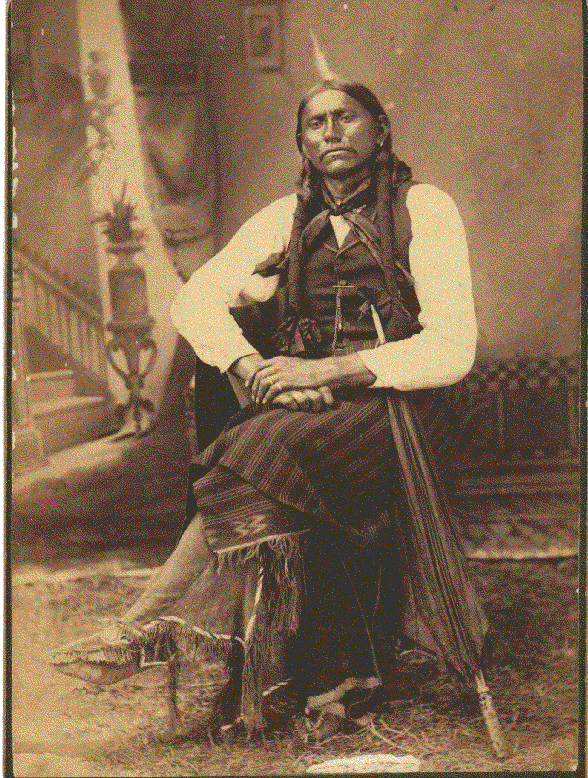
Quanah Parker - Comanche - circa 1890

Quanah Parker - Comanche - circa 1890

Quanah Parker - Comanche - circa 1890

Quanah Parker - Comanche - 1890

Quanah Parker - Comanche - 1890

Quanah Parker - Comanche - 1892

Quanah Parker - Comanche - 1892

Quanah Parker - Comanche - 1892

Quanah Parker - Comanche - 1892

Quanah Parker (seated second from left) Comanche – 1892

Quanah Parker with one of his wives named Dunas - Comanche - 1892

Quanah Parker with three of his wives - Comanche - 1892

Quanah Parker - Comanche - 1897

Quanah Parker - Comanche - 1900

Quanah Parker with three of his wives, a son and a baby - Comanche - 1905

Quanah Parker (seated far left on steps in #1 position) - Comanche - 1907


Quanah Parker - Comanche - 1908

His was the last tribe in the Staked Plains to come into the reservation system.
Quanah, meaning "fragrant," was born about 1850, son of Comanche Chief Peta Nocona and Cynthia Ann Parker, a white girl taken captive during the 1836 raid on Parker's Fort, Texas. Cynthia Ann Parker was recaptured, along with her daughter, during an 1860 raid on the Pease River in northwest Texas. She had spent 24 years among the Comanche, however, and thus never readjusted to living with the whites again.
She died in Anderson County, Texas, in 1864 shortly after the death of her daughter, Prairie Flower. Ironically, Cynthia Ann's son would adjust remarkably well to living among the white men. But first he would lead a bloody war against them.
Quanah and the Quahada Comanche, of whom his father, Peta Nocona had been chief, refused to accept the provisions of the 1867 Treaty of Medicine Lodge, which confined the southern Plains Indians to a reservation, promising to clothe the Indians and turn them into farmers in imitation of the white settlers.
Knowing of past lies and deceptive treaties of the "White man", Quanah decided to remain on the warpath, raiding in Texas and Mexico and out maneuvering Army Colonel Ronald S. Mackenzie and others. He was almost killed during the attack on buffalo hunters at Adobe Walls in the Texas Panhandle in 1874. The U.S. Army was relentless in its Red River campaign of 1874-75. Quanah's allies, the Quahada were weary and starving.
Mackenzie sent Jacob J. Sturm, a physician and post interpreter, to solicit the Quahada's surrender. Sturm found Quanah, whom he called "a young man of much influence with his people," and pleaded his case. Quanah rode to a mesa, where he saw a wolf come toward him, howl and trot away to the northeast. Overhead, an eagle "glided lazily and then whipped his wings in the direction of Fort Sill," in the words of Jacob Sturm. This was a sign, Quanah thought, and on June 2, 1875, he and his band surrendered at Fort Sill in present-day Oklahoma.
Biographer Bill Neeley writes:
"Not only did Quanah pass within the span of a single lifetime from a Stone Age warrior to a statesman in the age of the Industrial Revolution, but he accepted the challenge and responsibility of leading the whole Comanche tribe on the difficult road toward their new existence."
Quanah was traveling the "white man's road," but he did it his way. He refused to give up polygamy, much to the reservation agents' chagrin. Reservation agents being political appointees of the Federal Government, their main concern was to destroy all vestiges of Native American life and replace their culture with that of theirs. Quanah Parker also used peyote, negotiated grazing rights with Texas cattlemen, and invested in a railroad. He learned English, became a reservation judge, lobbied Congress and pleaded the cause of the Comanche Nation. Among his friends were cattleman Charles Goodnight and President Theodore Roosevelt. He considered himself a man who tried to do right both to the people of his tribe and to his "pale-faced friends".
It wasn't easy. Mackenzie appointed Quanah Parker as the chief of the Comanche shortly after his surrender, but the older chiefs resented Parker’s youth, and his white blood in particular." And in 1892, when Quanah Parker signed the Jerome Agreement that broke up the reservation, the Comanche were split into two factions: (1). those who realized that all that could be done had been one for their nation; and (2). those who blamed Chief Parker for selling their country."
Quanah Parker died on February 23, 1911, and was buried next to his mother, whose body he had reinterred at Ft. Sill Military cemetery on Chiefs Knoll in Oklahoma only three months earlier. For his courage, integrity and tremendous insight, Quanah Parker’s life tells the story of one of America's greatest leaders and a true Texas Hero.
Taken from:
www.lone-star.net/mall/texasinfo/quanah.htm
*******
Quanah Parker (c. late 1840s - February 23, 1911) was a Native American Indian leader, the son of Comanche chief Peta Nocona and European American woman Cynthia Ann Parker, and the last chief of the Quahadi Comanche Indians.
Quanah Parker's mother, Cynthia Ann Parker {b.ca 1827}, was a member of the large Parker frontier family that settled in east Texas in the 1830s. She was captured in 1836 by Comanches during the raid of Fort Parker near present-day Groesbeck, Texas. She was given the Indian name Nadua ("Someone Found"), and adopted into the Nocona band of Comanches. Cynthia Ann eventually married the Comanche warrior Noconie, (aka Tah-con-ne-ah-pe-ah) (called Peta Nocona by the whites), who was a Mexican captive. Quanah was her firstborn son. She also had another son, Pecos ("Peanut") and a daughter, Topsana ("Prairie Flower)" In 1860, Cynthia Ann Parker was recaptured in the battle of Pease River by Texas Rangers under Lawrence Sullivan Ross. Peta Nocona, Quanah, and most of the other men were out hunting when Ross' men attacked. Returning to find the aftermath, they found it difficult to get any information as only a few people were still alive. Meanwhile, Cynthia Ann was reunited with her white family, but years with the Comanches had made her a different person. She frequently demanded to return to her husband, but was never permitted to do so. After Topsana died of an illness in 1863, Cynthia Ann starved herself to death in 1870.
Soon after the Pease River battle, Peta Nocona was said to be a broken, bitter man. He was later wounded on a raid with Apaches. Already in ill-health, with an older war wound troubling him, he soon died. Before his death, he told Quanah of his mother's capture from the whites. With this revelation came taunts from other tribesmen that Quanah was a half-breed. With Nocona's death, his band split. Quanah joined the Destanyuka band, where Chief Wild Horse took him under his wing. Though he grew to considerable standing as a warrior, he never felt comfortable with the Destanyuka. He left and formed the Quahadi ("Antelope Eaters") band with warriors from another tribe. The Quahadis eventually grew in number, becoming the largest of the Comanche bands, and also the most notorious. Quanah Parker became a leader of the Quahadi, and led them successfully for a number of years.
In October, 1867, Quanah was among the Comanche chiefs at Medicine Lodge. Though he did not give a speech – his place was as an observer – he did make a statement about not signing the Medicine Lodge Treaty. His band remained free while other Comanches signed.
In the early 1870s, the plains Indians were losing the battle for their land. Following the capture of the Kiowa chiefs Satank, Adoeet (Big Tree), and Satanta, the Kiowa, Comanche, and Cheyenne tribes joined forces in several battles. Colonel Ranald Mackenzie was sent to eradicate all remaining Indians who had not settled on reservations.
In 1874, while in the Texas panhandle, a Comanche prophet named Isatai summoned the tribes to Adobe Walls, where several buffalo hunters were active. With Kiowa Chief Big Bow, Quanah was in charge of one group of warriors. The incident was his closest brush with death; he was shot twice.
With their food source depleted, and under constant pressure from the army, the Quahadi Comanches finally surrendered and in 1875 moved to a reservation in southwestern Oklahoma. His home in Cache, Oklahoma was called the Star House. Parker's was the last tribe of the Staked Plains or Llano Estacado to come to the reservation. Quanah was named chief over all the Comanches on the reservation, and proved to be a forceful, resourceful and able leader. Through wise investments, he became perhaps the wealthiest American Indian of his day in the United States. Quanah embraced much of white culture, and was well respected by the whites. He went on hunting trips with President Theodore Roosevelt. Nevertheless, he rejected both monogamy and traditional Protestant Christianity in favor of the Native American Church Movement. He had five wives and twenty five children and founded the Native American Church. One of his sons, White Parker, later became a Methodist minister.
Author Bill Neeley writes:
"Not only did Quanah pass within the span of a single lifetime from a Stone Age warrior to a statesman in the age of the Industrial Revolution,but he never lost a battle to the white man and he also accepted the challenge and responsibility of leading the whole Comanche tribe on the difficult road toward their new existence."
Quanah died on February 23, 1911. He is buried at the Fort Sill Cemetery, beside his mother and sister. The inscription on his tombstone reads:
Resting Here Until Day Breaks
And Shadows Fall and Darkness
Disappears is
Quanah Parker Last Chief of the Comanches
Born 1852
Died Feb. 23, 1911
--------
Quanah's grandfather was the Chief Iron Jacket, famous among the Comanches as a powerful chief who wore a Spanish coat of mail and was said to have the power to blow bullets away with his breath.
Quanah's first wife was Weakeah, daughter of Comanche chief Yellow Bear. Originally, she was espoused to another warrior. Quanah and Weakeah eloped, and took several other warriors with them. It was from this small group that the large Quahadi band would form. Yellow Bear pursued the band and eventually Quanah made peace with him, and the two bands united, forming the largest force of Comanche Indians.
Over the years, Quanah accumulated four more wives. He had twenty-five children. Many north Texans and south Oklahomans claim descent from Quanah. It had been said that more Comanches are related to Quanah than any other chief. One grandson became Comanche chairman, the modern "Chief" of the tribe.
After moving to the reservation, Quanah first got in touch with his white relatives. He stayed for a few weeks with them, where he studied English and western culture, and learned white farming techniques.
In his later years, Quanah carried on a correspondence by letter with Texas cattleman Charles Goodnight. Though Goodnight was illiterate, he dictated the letters to his wife, who in turn sent them to Quanah.
Taken from:
en.wikipedia.org/wiki/Quanah_Parker
*******
Quanah Parker - Comanche - circa 1869

Quanah Parker - Comanche - 1880

Quanah Parker - Comanche - circa 1888

Quanah Parker - Comanche - circa 1890

Quanah Parker - Comanche - circa 1890

Quanah Parker - Comanche - circa 1890

Quanah Parker - Comanche - 1890

Quanah Parker - Comanche - 1890

Quanah Parker - Comanche - 1892

Quanah Parker - Comanche - 1892

Quanah Parker - Comanche - 1892

Quanah Parker - Comanche - 1892

Quanah Parker (seated second from left) Comanche – 1892

Quanah Parker with one of his wives named Dunas - Comanche - 1892

Quanah Parker with three of his wives - Comanche - 1892

Quanah Parker - Comanche - 1897

Quanah Parker - Comanche - 1900

Quanah Parker with three of his wives, a son and a baby - Comanche - 1905

Quanah Parker (seated far left on steps in #1 position) - Comanche - 1907


Quanah Parker - Comanche - 1908






